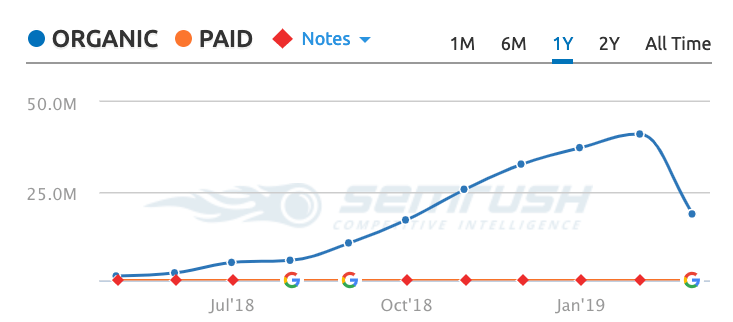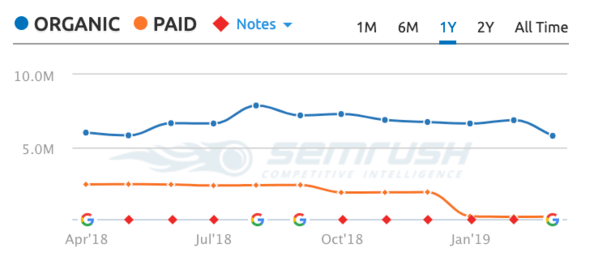Quality Content: A Long-Term Play That Avoids the Unpredictability of Google Updates
If your idea of SEO is trying to exploit flaws in Google’s ranking algorithm, then you’re sacrificing short-terms gains for long term success. Each major update, like the recent March 2019 Core Update, will bring with it a period of anxiety and trepidation. Every time the search engine Goliath zigs, you zag, in hopes of not being crushed.
It doesn’t have to be that way, not if you go for the long-term play – building a valuable resource site full of high-quality content.
But I get it. When things go wrong, you often need to find a solution quickly. The last thing you want to examine is your site’s content quality.
If you’re not using a platform like MarketMuse Suite that provides scalable measurement of content quality and comprehensiveness, automated site-wide and page-level gap analysis?
For many, the whole content quality issue is a can of worms which they do not want to open.
This post looks at few sites and how they have fared through the recent update. Keep in mind they’re getting millions of visits every month. For obvious reasons, we can’t reveal their identities.
A Technical Fix is No Substitute for Quality Content
Here’s a story of a well-known publisher in the health sector. For years they had done quite well following their existing strategy. However, they became concerned when traffic started to drop.
At a loss for an explanation, they eventually decided to break up their huge site into multiple smaller sites. The rational was that they could re-engineer these sites to improve organic traffic, while keeping essentially the same content.
And it worked! Until it didn’t.

Ignoring content while focusing on strictly a technical fix has come back to haunt this site. March 2019 has not been kind to their organic traffic.
Quality Content is Crucial But so is Quantity
It’s a given that you should always publish the best-quality content possible. While some pundits claim it’s advantageous to publish better quality content less frequently, I know of a very large tech publisher that might disagree.
They’ve essentially been resting on their laurels over the last year or so, not producing content in the quantity they had in the past. And it seems to have caught up with them – to the tune of a 16% drop in organic traffic in March.

Sites that people enjoy visiting, and to which they regularly link, continue to be pertinent. It’s hard to stay relevant if you’re not regularly publishing new content and updating existing material.
More Isn’t Always Better
Remember when listicles were all the rage? It seemed like was publishing list-based posts like “4 Ways to Cure the Common Cold” and “10 Reasons to Become an Entrepreneur.” The web quickly became saturated with this type of content. There was no subject matter too esoteric for a list! In that environment, the only way to differentiate one’s article was by increasing the size of the list.
Suddenly, 101 became the new 10.
The content wasn’t inherently better, it was just more. The rational was that if the competition can rank on page one with their 10-item list post, then a 20-item list post will surely rank higher.
Take for example a publisher for whom listicles were an important part of its content strategy.
And it worked for a while… until it didn’t.
This publisher lost 79% of its traffic in March 2019, dropping from 24 million visits to 5 million. Unfortunately for this site, SERPs containing long-form list pages are experiencing a lot of flux. In reality, this type of content provides a poor user experience. It may be that, despite any off-page factors, this form of content has simply run its course.
Regularly Publish High-Quality Content Focused on Your Audience
Admittedly, it’s not a sexy strategy but it works. Back in the summer of 2018, this review site decided to shift their focus. They began publishing content with the aim of creating the ultimate user experience. Their content is expertly crafted to match the intent behind specific search terms – and they publish quite frequently.

As a result, they’ve nearly doubled their organic traffic over the past seven months. Now, they lead the competition when it comes to organic search traffic and organic keyword rankings.
Search Engine Land provides some examples of a nutrition, small e-commerce and larger informational site that saw traffic gains after the March update. What they have in common is that they all made changes based on clues provided in Google’s Quality Raters’ Guidelines.
With any major Google update, there will be both winner and losers. Although we haven’t the fluctuations levels that we did with Google’s Medic Update in August 2018, it’s of little consolation if your site has experienced an 80% visibility decrease. If you’re curious to see the winners and losers from The March 2019 Core Update, see this list put together by RankRanger.
Remember that Google always strives to provide the highest quality and most relevant results for every search query. In the long run you can’t go wrong emulating that strategy.
Stephen leads the content strategy blog for MarketMuse, an AI-powered Content Intelligence and Strategy Platform. You can connect with him on social or his personal blog.